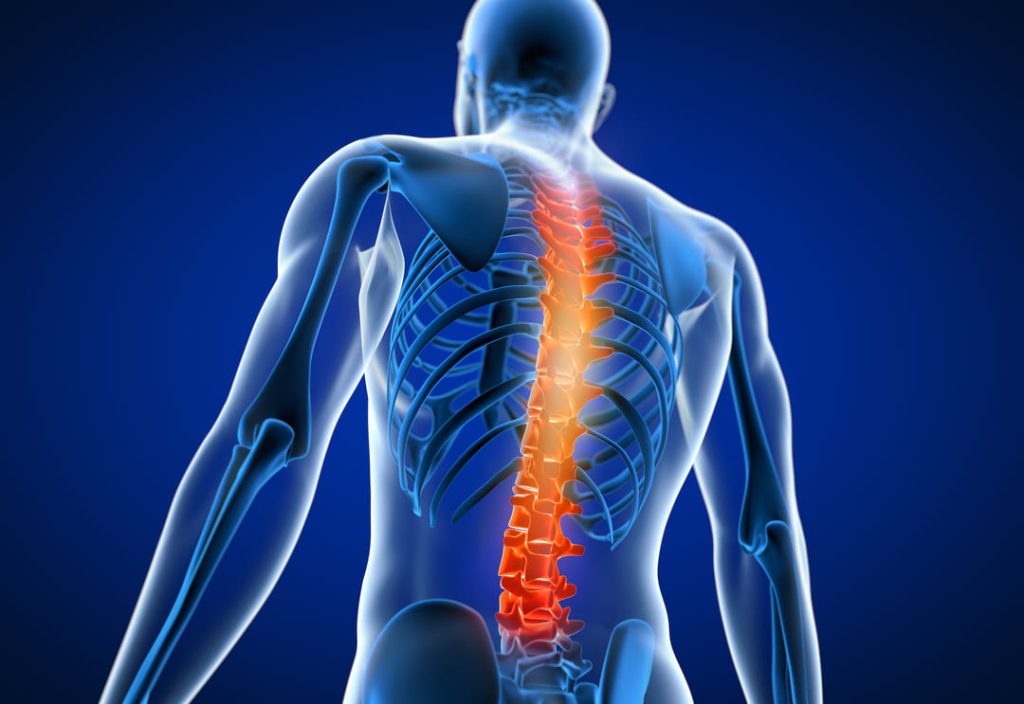Looking for Expert-Level VA Claim Answers?📱Call Us Now! 737-295-2226
The VA ranks back pain as the fifth most common VA disability amongst veterans, and it’s no surprise. As a service member, you put your body through intense training and conditioning, commonly leading to back issues. But what qualifies you for a back pain VA rating?
Heavy lifting, repetitive motions, jumping, and daily activities can cause injuries to your back. Despite your best efforts to take care of yourself, military duties often take a toll on your body.
This FREE Veteran’s Guide for Receiving a Back Pain VA Rating will cover how the VA rates back pain, different types of back pain, and practical tips to help you receive the highest rating you deserve. Let’s dive in!
Table of Contents

1. There are multiple different back pain conditions rated by the VA.
Like many VA disabilities, there isn’t one condition that causes back pain, which sometimes makes determining a diagnosis tricky. However, understanding your condition will help determine your back pain VA rating.
The most common back pain conditions rated by the VA
- Herniated Disc – A herniated or bulging disc is an injury that impacts your back, specifically your spine. You may also hear a herniated disc called a slipped disc.
- Arthritis – There are several types of arthritis of the back, including degenerative, traumatic, and rheumatoid, with degenerative arthritis being the most common found in veterans.
- Lumbosacral Strain – An injury to the lower back affecting the lumbosacral spine, causing muscle spasms, pain, limited mobility, numbness or tingling, stiffness, and inflammation.
- Vertebral Fracture – A break to the spine or when the spine is out of place.
- Degenerative Disc Disease – When the discs between the vertebrae lose cushioning, leaving them more prone to damage or tearing.
- Intervertebral Disc Syndrome (IVDS) – Affects the discs between the vertebrae in your spine, leading to pain, discomfort, and numbness. With IVDS, one or more of the discs begins breaking down.
Remember, this doesn’t cover all back pain-related conditions, and you may still qualify for a back pain VA rating even if your condition isn’t listed above.
2. There can be several causes of service-related back pain.
It’s no secret that service members put their bodies through enormous stress while on active duty. With that comes a host of back-related conditions that can affect your quality of life.
Here’s a look at the top causes of service-related back pain:
- Strenuous physical training
- Heavy lifting
- Improper lifting
- Repetitive motions
- Jumping and pivoting
3. Get the treatment that you need.
Common treatment options for back pain in veterans include:
- Physical therapy
- Medication
- Massage therapy
- Acupuncture
- Surgery
Not all back pain conditions require surgery, but it might be recommended if nonsurgical options have been unsuccessful for at least six months to a year.

4. Know how to prove back pain is service-connected.
Before receiving your back pain VA rating, you must prove your condition is service-connected, entitling you to benefits.
To prove your back pain is service-connected, you must provide the following:
- A current diagnosis of your back condition or evaluation of your disability from a medical professional; and
- An in-service injury, event, or illness; and
- A medical nexus (or link) connecting your diagnosed back condition to the in-service injury, event, or illness
Examples of in-service injuries include training or combat injuries, accidents, and more. Although these are just a few examples, your specific condition may still qualify you for a back pain VA rating.
Unfortunately, despite your pain level, if you can’t prove your back is service-connected, you likely will be denied a back pain VA rating.
Read our How to File a Claim to help answer questions about correctly submitting your claim!

5. Your Range of Motion matters.
A veteran’s range of motion is likely the most substantial evidence when determining a back pain VA rating. Since a medical examiner can’t decipher a service member’s pain level, they rely on range of motion to decide an appropriate VA rating.
The VA determines the range of motion for a back pain VA rating based on the following:
- Flexion – Involves bending your body sideways
- Extension – Involves the straightening of your body
- Rotation – The extent to which a body part can move around a joint or a fixed point
6. Know what to expect with your rating.
The average VA disability rating for musculoskeletal conditions is 10%, but if you’ve had surgery, you’ll likely receive a rating of 20% or more. However, if you have a full range of motion with pain, you should at least be eligible for a 10% back pain VA rating.
You DESERVE a HIGHER VA rating.
Take advantage of a VA Claim Discovery Call with an experienced Team Member. Learn what you’ve been missing so you can FINALLY get the VA disability rating and compensation you’ve earned for your service.
7. Learn how to get a higher VA rating for back pain.
You must provide sufficient evidence proving your case to get a higher VA back pain rating. In addition, to receive the maximum back pain VA rating of 100%, you must show your “entire spine is frozen in an unfavorable position.”
Here’s a look closer at what that means:
- Entire spine – This refers to your middle (thoracolumbar spine), lower back, and neck (cervical spine).
- Frozen – You have nearly no range of motion in your spine.
- Unfavorable position – Your spine is fixed in a curved or non-neutral position. However, a spine in the neutral position (0 degrees) is considered “favorable” ankylosis and likely would qualify for a lower back pain VA rating.
However, that isn’t an easy qualification, so don’t be surprised if your VA rating doesn’t hit the 100% mark.
Pro Tip: If your claim was denied and you feel entitled to a back pain VA rating, you can appeal the decision. You can also combine your back pain with another service-connected condition to increase your VA rating. However, you must still prove the condition is service-connected to receive disability benefits and compensation.
8. TDIU Benefits may increase your total VA compensation.
If you receive a back pain VA rating that is lower than you want, you may be eligible for total disability based on individual employability (TDIU). TDIU offers qualified veterans a 100% disability rate if their service-connected condition prevents them from attaining substantially gainful employment.
However, TDIU requires veterans to have at least one condition with a 60% or greater rating or two or more disabilities equal to at least a 70% rating with at least one rated at 40% or more.
9. Keep up with your treatments and keep a record of your ongoing symptoms.
Are VA benefits for back pain permanent? Since back pain can come and go, you might wonder if the same applies to your back pain VA rating.
You can establish that you have a permanent disability, but you must have medical records to prove that your condition will either remain unchanged or worsen over the course of your life.
However, the VA will likely schedule follow-up appointments every few years to check on your condition and its severity.

10. Know how the VA rates back pain.
The VA rates back pain from 10-100%, depending on Painful Motion, Limitation of Range of Motion, and Functional Loss or Impairment. Your back pain VA rating will determine your compensation and benefits, highly impacting your quality of life.
Here’s a closer look at what goes into a back pain VA rating:
- Painful motion – This principle means that regardless of motion, if pain exists, the service member should receive at least the minimum level of disability for their condition.
- Limitation of Range of Motion – Likely the most crucial principle because a significant component of determining disability is how much mobility you have.
- Functional Loss – This principle of back pain refers to the impairment of spine function determined by the range of motion. It is usually caused by pain, fatigue, weakness, lack of endurance, and incoordination.
Pro Tip: If you experience flare-ups that worsen your condition, you may be eligible for a higher VA rating.
You can find the back pain VA rating under CFR Title 38, Part 4, Schedule for Rating Disabilities, General Rating Formula for Diseases and Injuries of the Spine. You’ll notice the range of motion plays a significant factor when deciding your back pain VA rating.
According to the VA chart, the C&P examiner must perform a range of motion test to ensure you receive the appropriate rating. In addition, ensure the C&P examiner uses a goniometer for testing, or you likely will receive an improper rating.
Back Pain VA Rating Chart
| General Rating Formula for Diseases and Injuries of the Spine | VA Rating |
| Unfavorable ankylosis of the entire spine | 100% |
| Unfavorable ankylosis of the entire thoracolumbar spine | 50% |
| Unfavorable ankylosis of the entire cervical spine; OR Forward flexion of the thoracolumbar spine 30 degrees or less; ORFavorable ankylosis of the entire thoracolumbar spine | 40% |
| Forward flexion of the cervical spine 15 degrees or less; ORFavorable ankylosis of the entire cervical spine | 30% |
| Forward flexion of the thoracolumbar spine greater than 30 degrees but not greater than 60 degrees; ORForward flexion of the cervical spine greater than 15 degrees but not greater than 30 degrees; or, the combined range of motion of the thoracolumbar spine not greater than 120 degrees; ORThe combined range of motion of the cervical spine is not greater than 170 degreesMuscle spasm or guarding severe enough to result in an abnormal gait or abnormal spinal contour such as scoliosis, reversed lordosis, or abnormal kyphosis | 20% |
| Forward flexion of the thoracolumbar spine greater than 60 degrees but not greater than 85 degrees; ORForward flexion of the cervical spine greater than 30 degrees but not greater than 40 degrees; ORCombined range of motion of the thoracolumbar spine greater than 120 degrees but not greater than 235 degrees; ORCombined range of motion of the cervical spine greater than 170 degrees but not greater than 335 degrees; OR Muscle spasm, guarding, or localized tenderness not resulting in abnormal gait or abnormal spinal contour; or, vertebral body fracture with loss of 50 percent or more of the height | 10% |
*If no limitation of range of motion is observed, but the claimant has painful motion, the minimum back pain VA rating of 10% should be applied.
Intervertebral Disc Syndrome VA Rating Chart
| The formula for Rating Intervertebral Disc Syndrome Based on Incapacitating Episodes | VA Rating |
| With incapacitating episodes having a total duration of at least 6 weeks during the past 12 months | 60% |
| With incapacitating episodes having a total duration of at least 4 weeks but less than 6 weeks during the past 12 months | 40% |
| With incapacitating episodes having a total duration of at least 2 weeks but less than 4 weeks during the past 12 months | 20% |
| With incapacitating episodes having a total duration of at least one week but less than 2 weeks during the past 12 months | 10% |
| Note (1): For purposes of evaluations under diagnostic code 5243, an incapacitating episode is a period of acute signs and symptoms due to intervertebral disc syndrome that requires bed rest prescribed by a physician and treatment by a physician. | |
| Note (2): If intervertebral disc syndrome is present in more than one spinal segment, provided that the effects in each spinal segment are clearly distinct, evaluate each segment on the basis of incapacitating episodes or under the General Rating Formula for Diseases and Injuries of the Spine, whichever method results in a higher evaluation for that segment. |
11. Attend your Compensation & Pension (C&P) exam.
To receive a proper back pain VA rating, you will likely be given a Compensation & Pension (C&P) exam, where an examiner will determine how far you can bend backward, forward, and side-by-side using a goniometer. Do not skip your C&P exam or forget to go.
It’s best to be honest during your C&P exam, allowing the examiner to understand your condition entirely.
When your C&P exam is complete, the VA determines the severity of the condition based on your range of motion measurements from the test.
12. Learn if you qualify for secondary conditions to back pain.
Secondary conditions occur when a service-connected disability has caused or aggravated a new or pre-existing condition, illness, or injury. Since back pain in veterans likely reduces their activity level, it puts them at a greater risk of secondary conditions.
There are several secondary conditions to back pain, including:
- Paralysis
- Erectile dysfunction
- Sciatic nerve damage
- Cardiovascular disease
- Depression
- Anxiety
- Adjustment disorder
Remember, you may develop secondary conditions that are either physical or psychological.
13. Radiculopathy and back pain may be connected.
Veterans suffering from spine conditions are more likely to develop nerve problems, especially radiculopathy.
Radiculopathy is one of the most common secondary conditions to back pain. It’s caused by compressed nerves in the spine, resulting in numbing, tingling, pain, and weakness along the nerve.
If you experience radiculopathy due to a lower back condition, you’ll likely feel symptoms in your lower extremities, like the calf, foot, or thigh. Remember, if you develop a new disability or worsen an existing condition, you may be eligible for secondary service-connected benefits.
14. Know you can’t receive a VA rating for multiple back conditions?
A single condition can only be rated once; however, if a nerve condition or other condition exists that is additional to the spine condition (not simply caused by it), then it can also be rated.
The VA refers to this as “Avoidance of Pyramiding,” which applies to any other VA disability.

Need More Assistance?
Proving your back pain is service-related can be challenging, but we are here to help, ensuring you receive your deserved back pain VA rating.
Most veterans are underrated for their disabilities and, therefore, not getting their due compensation. At VA Claims Insider, we help you understand and take control of the claims process, so you can get the back pain VA rating and compensation you’re owed by law.
Our process takes the guesswork out of filing a VA disability claim and supports you every step of the way in building a fully-developed claim (FDC)—so you can increase your rating FAST! If you’ve filed your VA disability claim and have been denied or have received a low rating—or you’re unsure how to get started—reach out to us! Take advantage of a VA Claim Discovery Call. Learn what you’ve been missing—so you can FINALLY get the disability rating and compensation YOU DESERVE!



